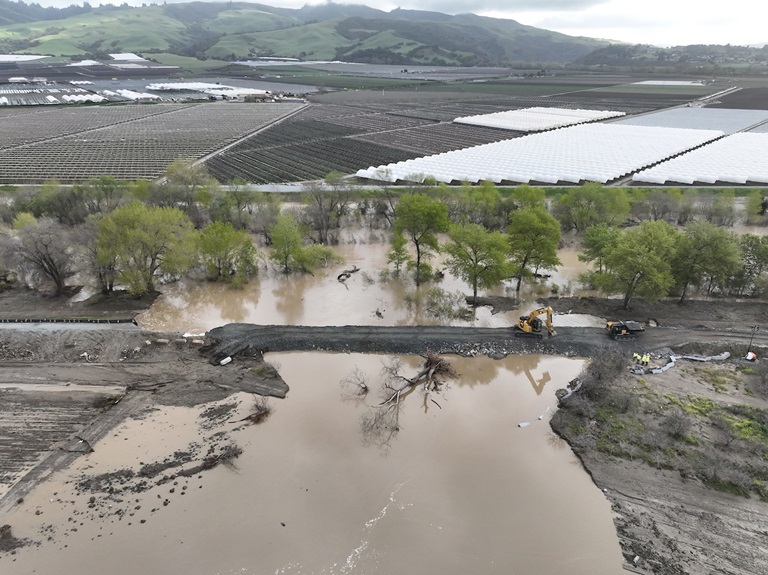DWR Supports Flood Fight Efforts at Pajaro River Levee Break
A drone provides a view of construction equipment placing rock to close a levee break caused by floodwaters from the Pajaro River near the township of Pajaro in Monterey County, California. The floodwater breached the levee around midnight on March 10, 2023.
As storms continue to bring rain and snow to California this winter, the Department of Water Resources (DWR) is working to provide support to communities impacted by flooding. One recent high-profile event was the levee break along the Pajaro River in Monterey County.
During the storms in early March, there were growing concerns about the conditions of rural levees along the Pajaro River, threatening the downstream community of Pajaro. As part of DWR’s efforts to support communities statewide with flood response, DWR deployed a Flood Fight Specialist team to the location at the county’s request to assess conditions.
“The State-Federal Flood Operations Center retains a highly trained team of flood fight specialists and other flood management experts that stand ready to assist local agencies during high water events,” said Jeremy Arrich, Manager of DWR’s Division of Flood Management. “DWR and the FOC are in constant communication with local levee managers and continually monitor conditions across the state to ensure we are ready to assist local agencies in addressing flood threats and act quickly to protect communities.”
Following an evacuation order for the town of Pajaro, the DWR flood fight crew began to raise the levee with the assistance of a team from CAL FIRE. Flood fighting efforts continued through the evening until around 11:30 p.m. on March 10 when it was determined that it was no longer safe for flood fight crews to continue working in the area. Shortly after, a levee break occurred at this location.
The following morning, the break was assessed by DWR flood fight specialists and engineering contractor staff and plans were developed to enable access to the site by equipment and crews. Work to stabilize the existing levee as well as the break site began on March 12 and continued around the clock resulting in the closure of the break on the evening of March 14. The initial closure was approximately 4 to 6 feet below the existing crown with approximately another week of work required to raise the crown to the height of the existing levee.
The Pajaro River roughly defines the border between Santa Cruz and Monterey Counties and empties into Monterey Bay west of Watsonville. The levees at the location of the break were constructed in 1949 by the U.S. Army Corps of Engineers (USACE) and are maintained by the Monterey County Water Resources Agency. A population of around 3,600 people and more than 800 structures depend on these levees for protection from high river flows resulting from storms like those California has experienced this year.
These high flows can occur rapidly due to runoff from the steep coastal mountain range, increasing pressure on the levees. Recognizing this flood risk, DWR’s Local Levee Assistance Program completed a funding agreement in 2013 to provide $3.15 million for the Pajaro River Bench Excavation Project, which removed excess sediment from select locations to improve flood conveyance capacity.
Long-term levee improvements to the levee system on both sides of the river and its major tributary Salsipuedes Creek, have been authorized by USACE and will be implemented in seven stages by the Pajaro Regional Flood Management Agency. Additionally, special legislation authored by Senator John Laird (SB 496) requires DWR to pay 100 percent of the State’s cost share due to the disadvantaged economic status of homeowners in the neighboring communities of Pajaro and Watsonville. DWR has provided $7 million in key early-stage work for this project through DWR’s Coastal Watershed Flood Risk Reduction Program.
DWR’s Flood Operations Center will continue monitoring forecasts and conditions closely and is coordinating with CalOES and other state and local partners to complete emergency work on the Pajaro River system and prioritize public safety.
